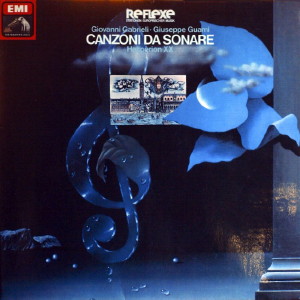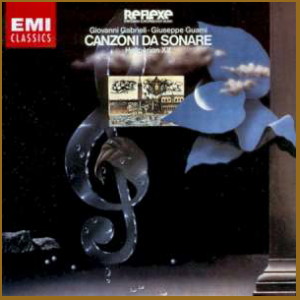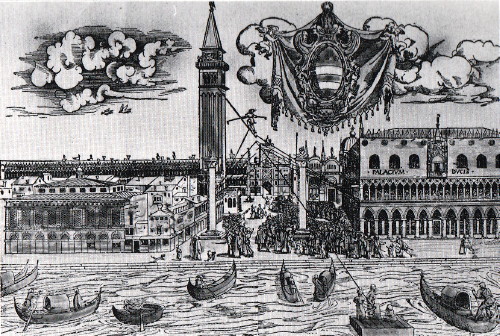 |
1 LP -
1C 065-45 646 - (p) 1979
|

|
| 1 CD - 8
26521 2 - (c) 2000 |
 |
| 1 CD -
CDM 7 63141 2 - (c) 1989 |
|
| CANZONI
DA SONARE |
|
|
|
|
|
| Canzon 1. toni à
10 (1597) - (Giovanni
Gabrieli, um 1555-1612) - Tutti,
Cembalo |
2' 44" |
|
| Canzon La
Cromatica à 4 (1601) -
(Giuseppe Guami, zwischen 1530 u.
1540-1611) - Viole da gamba |
3' 46" |
|
| Canzon
I La Spiritata à 4 (1608) - (Giovanni Gabrieli,
um 1555-1612) - 2 Zinken, 2
Posaunen, Orgel |
2' 54" |
|
| Canzon
sopra "Qui la dira" - (Andrea Gabrieli, um
1510-1586) - Cembalo |
4' 12" |
|
| Canzon
III à 6 (1615) - (Giovanni Gabrieli,
um 1555-1612) - Viole da gamba,
Laute |
3' 07" |
|
Canzon
XXIV à 8 (1608) - (Giuseppe
Guami, zwischen 1530 u. 1540-1611)
|
2' 54" |
|
| -
1. Choro: Viole da gamba, Laute |
|
|
| -
1. Choro: 2 Zinken, 2 Posaunen,
Cembalo, Violone |
|
|
| Canzon
I à 5 (1615) - (Giovanni Gabrieli,
um 1555-1612) - 2 Zinken, 3
Posaunen |
2' 44" |
|
| Canzon
sopra La Battaglia à 4 (1601)
- (Giuseppe Guami, zwischen 1530 u.
1540-1611) - Viole da gamba,
Gitarre |
3' 56" |
|
| Canzon
12. toni à 10 (1597) - (Giovanni Gabrieli,
um 1555-1612) - Tutti, Cembalo |
2' 41" |
|
|
|
|
| Canzon
II à 4 (1605) - (Giovanni
Gabrieli, um 1555-1612) - Viole
da gamba, Orgel |
2' 36" |
|
| Canzon
La Gualmina à 4 (1601) -
(Giuseppe Guami, zwischen 1530 u.
1540-1611) - 2 Zinken, 2
Posaunen, Orgel |
2' 10" |
|
| Canzon
VII à 7 (1615) - (Giovanni
Gabrieli, um 1555-1612) - 2
Zinken, 3 Viole da gamba, 2
Posaunen, Violone, Cembalo |
3' 08" |
|
| Canzon
La Accorta à 4 (1601) -
(Giuseppe Guami, zwischen 1530 u.
1540-1611) - Zink, 3 Viole da
gamba, Orgel |
2' 50" |
|
| Canzon
XXVII à 5 (1608) - (Giovanni
Gabrieli, um 1555-1612) - 2
Zinken, 4 Viole da gamba, 2
Posaunen, Violone, Cembalo |
2' 40" |
|
| Ricercar
sopra Re fa mi don à 4 -
(Giovanni Gabrieli, um 1555-1612) -
Viole da gamba |
5' 07" |
|
| Canzon
XXV à 8 (1608) - (Giuseppe
Guami, zwischen 1530 u. 1540-1611) |
2' 23" |
|
| -
1. Choro: 2 Zinken, 2 Posaunen,
Cembalo |
|
|
| -
2. Choro: Viole da gamba, Laute,
Violone |
|
|
| Canzon
12. toni à 10 (1597) -
(Giovanni Gabrieli, um 1555-1612) -
Tutti, Cembalo |
5' 20" |
|
|
|
|
HESPÈRION XX
|
Instrumente: |
|
| -
Jordi Savall, Diskantgambe |
-
Italienische Diskantgambe unsigniert
(um 1550)
|
|
| -
Christophe Coin, Diskant- und
Altgambe |
-
Diskantgambe unsigniert (um 1700) |
|
| -
Masako Hirao, Tenorgambe |
-
Altgambe von Henry Jaye, Southwark
1629 (1)
|
|
| -
Sergi Casademunt, Baßgambe |
-
Tenorgambe nach John Rose (1598) von
Paul J. Reichlin |
|
| -
Roberto Gini, Baßgambe |
-
Italienische Tenorgambe unsigniert
(1650) |
|
| -
Pere Ros, Violone und Baßgambe |
-
Baßgambe von Pellegrino Zanetto,
Venedig 1550 |
|
| -
Bruce Dickey, Zink |
-
Baßgambe von Barak Norman, London
1697 |
|
| -
Jean-Pierre Canihac, Zink |
-
Violone nach Giovanni Paolo Maggini
(um 1610) von Hans Peter Rast |
|
| -
Jean-Pierre Mathieu, Alt- und
Tenorposaune |
-
Zinken von Philippe Matharel (um
1620) und Christopher Monk |
|
| -
Charles Toet, Tenorposaune |
-
Alt und Tenorposaune von Adolf Egger |
|
| -
Richard Lister, Baßposaune |
-
Tenorposaune M. A. Schnitzer (1581)
(2) |
|
| -
Ton Koopman, Clavicembalo und
Orgel |
-
Tenor- und Baßposaune nach Sebastian
Heinlein (Nürnberg 1621) von Meinl
und Laube
|
|
| -
Hopkinson Smith, Laute und
Gitarre |
-
Cembalo nach einem Instrument um
1580, von Othmar Zumbach |
|
|
-
Orgelpositiv von Bernhard Fleig |
|
|
-
7 chörige Laute von Joel van Lennep |
|
|
-
5 chörige Gitarre von Joel van
Lennep |
|
|
|
|
|
(1)
Aus dem Sammlung historische
Musik-Instrumente im Germanischen
National-Museum Nürnberg |
|
|
(2)
Musée Instrumental du Conservatoire,
Nice |
|
|
|
|
|
Luogo
e data di registrazione |
|
Kirche,
Séon (Svizzera) - 9-13 ottobre
1978 |
|
|
Registrazione: live /
studio |
|
studio |
|
|
Producer / Engineer |
|
Gerd
Berg / Johann-Nikolaus Matthes |
|
|
Prima Edizione LP |
|
EMI
Electrola "Reflexe" - 1C 065-45
646 - (1 lp) - durata 56' 06" -
(p) 1979 - Analogico |
|
|
Prima Edizione CD |
|
EMI
"Classics" - CDM 7 63141 2 - (1
cd) - durata 56' 06" - (c) 1989 -
ADD |
|
|
Edizione CD |
|
EMI
"Classics" - 8 26521 2 - (1 cd) -
durata 56' 04" - (c) 2000 - ADD |
|
|
Note |
|
-
|
|
|
|
|
|
 THE
INSTRUMENTAL CANZONA THE
INSTRUMENTAL CANZONA
ln the sixteenth century the
main church of Venice, the
basilica of St Mark’s,
had two organists. Among the
famous musicians who held
these posts were Giovanni
Gabrieli (c. 1553/56-1612)
and Gioseffo Guami (c.
1540-1611). While the
Venetian Gabrieli studied
with his uncle, Andrea,
Guami was a pupil of Adrian
Willaert in Venice. As young
musicians, both spent a few
years (up to 1579) at the
Munich court chapel under
Orlando di Lasso. Gabrieli
was organist of St Mark’s
for over 20 years from 1584;
in 1588-91 he served
alongside Guami, who then
went back to his home town
of Lucca. Nevertheless,
Guami’s Partidura per
sonare delle canzonette
was published in Venice in
1601. Of course, both
organists wrote not only for
the organ: their successive
publications contain
examples of all the
important genres of the
time, mainly motets and
madrigals but also an
increasing number of works
for instrumental ensembles,
in particular in the most
modern form, the canzona. In
the anthology of 36 canzonas
“for every kind of
instrument” published by
Alessandro Raveri in 1608 in
Venice, Gabrieli and Guami
are equally represented.
However, Gabrieli is
undoubtedly the superior
composer, and the standards
he set were promulgated
throughout Italy by his
German pupils Aichinger,
Hassler, and Schütz.
As the character and forms
of instrumental music
changed and were developed
(particularly by Gabrieli),
the way was paved for the
structural and tonal
transformations that led
from the Renaissance to the
early Baroque. The
Renaissance ideal of
independent partwriting
according to the rules of
polyphony still obtained
even in instrumental forms
in the mid-sixteenth
century. If
vocal and instrumental parts
still seemed to be
interchangeable in
performance, they
nonetheless now had their
own distinct character. The
sixteenth century saw the
emancipation of instrumental
music: title-page
indications that pieces
could be sung or played
disappeared as purely
instrumental forms
developed. There is still no
individual idiom for most
instruments, and indications
of instrumentation are
relatively rare: in general
the name of a part gives its
register, and the choice of
instrumentation is left to
the interpreter. This
freedom offered numerous
possibilities in view of the
rich variety of instruments
available. While at the end
of the Middle Ages
instruments of different
kinds (blown, bowed,
plucked) readily played
together, the sixteenth
century favoured the blended
sound of consorts of
matching instruments. Thus
SATB families of the basic
instrumental types
developed. Among them were
the recorder and the
increasingly important viol.
Alto, tenor and bass
instruments (Pommer)
completed the shawn family,
while the nimble cornett
became the top member of the
trombone family.
The development of
independent instrumental
ensemble music took place
above all in Italy, and
primarily through the Venetians
Willaert and Buus. The lack
of a text or a given cantus
firmus
is compensated for by the
structural use of
counterpoint. The present
ricercare by Giovanni
Gabrieli (from a source
manuscript) has as its theme
an abstract sequence of
notes, re-fa-mi-do
(D-F-E-C),
whose elaborate treatment
through several fugal
sections includes inversion
and diminution. From the
1570s in Italy the
“academic” ricercare was
largely superseded by the
canzona. This new
instrumental form derived
from the French chanson and
was at first called the canzona
alla francese per sonare.
The characteristic even and
pointed declamatory
rhythms of the chanson had
quickly been seen as being
especially suited to
instrumental performance.
The typical opening dactyl
rhythm continues to be found
in Gabrieli's
late canzonas.
Janequin’s Chanson La
Bataille (1530) is
especially famous for its
programmatic depiction of a
battle. Numerous battle
compositions, including
those by Guami, take over
features from it, among them
regular rhythmic patterns,
triadic “trumpet-call”
motifs and agitated,
interweaving part-writing.
The pleasing style of the
lively chanson made it
popular throughout Europe in
numerous instrumental
arrangements, particularly
for lute and for keyboard.
Andrea Gabrieli's canzona on
Qui la dira (from his
Canzoni alla francese per
sonar sopra istromenti da
tasti of 1605) is one
of numerous instrumental
versions of this chanson.
Gabrieli does not merely
adapt the chanson for his
instrument, but rather
paraphrases it by taking its
motifs as the basis for
longer imitative sections
and decorating the material
with ornamentation idiomatic
to the keyboard. Such
procedures gave the
instrumental canzona its own
characteristics.
From such arrangements
finally sprang the free
ensemble canzona, which was
newly composed rather than
being based on a
pre-existing composition.
Popular with composers in
northern Italy around 1600,
among them Banchieri,
Canale, G. D. Rognoni and
Massaino, it allowed fullest
scope for their
inventiveness, since the
absence of schematic forms
or rules free rein to
invention and innovation.
This diversity is a
particular feature of
Giovanni Gabrieli`s
canzonas. In clearly
articulated sections,
passages of ricercare-style
imitative writing and
chordal, homophonic passages
follow each other, the metre
varies between common time
and dancing triple-time,
sections are repeated. This
richness of alternation,
rhythm, tempo and phrasing
reflected the new Baroque
striving for contrast. The
open form offered full scope
for individuality too, as
may be seen from the
character titles in Guami's
1601 collection: La
Cromatica, for
instance, uses devices from
the contemporary dramatic
madrigal. The canzona
offered many possibilities
for new instrumental
effects, and the individual
parts soon became
idiomatically instrumental,
with leaps and figures quite
untypical of vocal writing.
Likewise such concertante
features as virtuoso
passages for single solo
instruments and the use of
contrasting instrumental
colours appeared, and the
number of parts increased.
In 1597 Gabrieli took the
number of parts in one
self-contained instrumental
“choir” to ten. This
expansion of texture made
multiple imitation of a
motif possible, while at the
same time the alternating of
different combinations of
instruments resulted in
varying gradations of sound
and also in an almost
block-like density. This led
increasingly to a texture in
which the melodic top part
and harmonically related
bass played the leading
role. Most
editions therefore add an
accompanying figured
bass.The slow speed of
harmonic rhythm also
contributes to the
expansiveness of sound.
Although Gabrieli still
specified the ecclesiastical
modes, his harmony
approaches the major-minor
concept of modern tonality.
Gabrieli’s 36 canzonas,
published between 1597 and
1615, are already more
diverse in polyphonic
technique than Guami’s 26
works. Just in the standard
forces of one or two
fourpart choirs, to which
Guami limits himself,
Gabrieli offers far more
variety. The ten parts of
the canzonas heard here form
one instrumental group, but
in another canzona Gabrieli
separates the instruments
into two groups which (he
still calls “choirs").
The double choirs were
partly suggested bythe two
organs of St. Mark's,
but more particularly by the
north Italian chori
spezzati tradition of
psalm-singing. The
increasing role of
instruments and the
establishing of purely
instrumental forms resulted
in splendid canzonas for
several choirs. Part 1 of
Guami’s Canzona XXIV shows
the basic principle
particularly clearly. A
closed thematic phrase is
stated by one choir and
repeated identically by the
other. This simple
alternation is developed
into a dynamic form by the
interweaving of phrases,
overlapping of instrumental
groups and more powerful
recapitulation in the tutti.
The other extreme is seen in
the eight-part Canzona XXVII
(1608) by Gabrieli,which is
unique in its complexity.
The motivic imitation in the
upper parts and the
dovetailing of the choirs is
so close and dense that only
at one point is the
double-choir layout clearly
audible. Furthermore, an
ostinato-like cadence
formula in the bass is heard
32 times through this
unusual piece. There are two
important factors in this
early Baroque concept of
music: tonal colour and
spatial effect. While
special tone colour is
achieved in Gabrieli’s
ten-part canzonas by the
effect of strings and wind
playing together, tonal
colours are contrasted in
the double-choir canzonas of
Guami. The internal musical
spatial effects in
Gabrieli’s use of the upper
and lower registers in his
ten-part
pieces takes on a spatial
aspect with the double
choir. The placing of
individual instrumental
ensembles in separate places
creates a new effect for the
listener, who is enveloped
in sound that fluctuates in
effect and structure. With
their balconies, galleries
and podia, Baroque churches
- in particular St Mark’s
- provided the architectural
stimuli and conditions for
the realisation of this
spatial art: canzonas,
though instrumental, were
not exclusively secular.
Contemporary accounts tell
us that canzonas were
favourite pieces for festive
public occasions, and they
originated as Staatsmusik
in many cases, though they
were also played to
entertain in the palaces of
the nobility and of
patricians. State
receptions, remembrance days
and, celebrations of victory
were also invariably
accompanied by
ecclesiastical celebrations
rich in pageantry. The
inclusion of canzonas
together with festive motets
in Giovanni Gabrieli’s Sacrae
symphoniae of 1597
demonstrates their
integration into
ecclesiastical music. It
was the task of the church
to articulate the
significance of the city
state in brilliant
ceremonies. As the main
church of the state, St Mark's
was the place of public
ceremonial. Gabrieli was
thus (in 1615) “Organist of
St Mark`s
for the Republic of Venice”.
Since 1567 St Mark’s
had engaged its own
instrumentalists, who were
joined on special occasions
by extra players to form
larger ensembles. Venice
stood not only at the height
of its economic power, but
was also the centre of
artistic activity for
northern Italy and beyond.
The artistic diversity of
the canzona reflects a part
of this great city’s
culture.
Klaus
Wolfgang Niemöller
|
|
|
EMI Electrola
"Reflexe"
|
|
|
|

